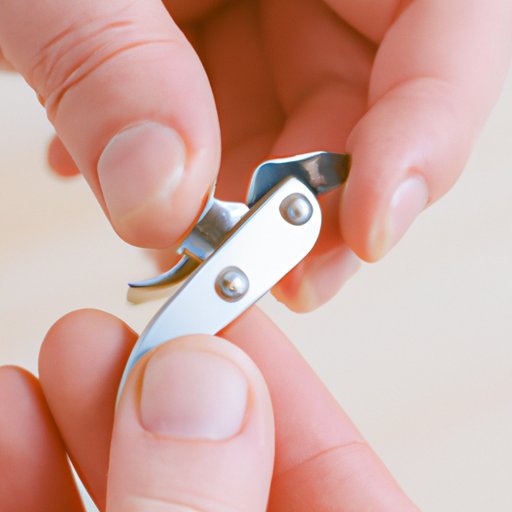I. Introduction
Trimming a dog’s nails can seem daunting for a lot of pet owners. However, regular nail trims are important for proper grooming and to avoid injuring your furry friend. Long nails can cause pain and discomfort, as well as improper posture and even infections. In this article, we’ll explore different types of dog nail clippers, provide a step-by-step guide for trimming nails, offer tips for identifying the quick, and discuss the benefits of regular nail trims. After reading this article, you’ll be confident in keeping your pup’s nails healthy and trimmed.
II. Different Types of Dog Nail Clippers
There are several types of dog nail clippers available, each with its pros and cons.
Guillotine Clippers: This type of clipper has a hole where you insert the nail, and then a blade presses down to cut it. They are easier to use with smaller dogs and for dogs with thinner nails, but may not be as effective for larger dogs or dogs with thicker nails.
Scissor Clippers: Similar to scissors, they have two blades that come together to make the cut. These clippers are versatile and can work well for dogs of all sizes, but may require more force to cut thicker nails.
Dremel Grinders: These are motorized grinders that sand down the nail instead of cutting. They are helpful for dogs who are afraid of clippers, but can be more time-consuming to use and may require more cleaning.
III. A Step-by-Step Guide for Trimming a Dog’s Nails
Before starting, you’ll need to have your dog’s favorite treats on hand and a styptic powder or some cornstarch in case of bleeding.
- Position your dog: Place your dog on a non-slip surface, such as a rubber mat. If your dog is comfortable, you can hold their paw and gently extend the nail. If not, you can try securing them with a harness or getting someone to help hold them still.
- Identify the quick: The quick is the pink area in the center of the nail that contains blood vessels and nerves. Try to avoid cutting this area, as it can be painful and may cause bleeding.
- Make the cut: Using your preferred nail clippers, make a straight cut across the nail. Try to cut below the quick but above the point where the nail starts to curve.
- Check for bleeding: If the nail bleeds, use a damp tissue with styptic powder or cornstarch to stop the bleeding. Offer your dog some treats and praise for being a trooper.
IV. Tips for Identifying a Dog’s Quick and Handling an Uncooperative Dog
If you have a dog with dark-colored nails, it can be challenging to identify the quick. However, if you look closely, you should see a small black dot in the center of the nail. You can also shine a flashlight under the nail to help make it more visible. If you’re unsure, it’s best to trim small pieces at a time until you can see the quick.
If your dog is uncooperative during the trimming process, try to remain calm and take breaks if needed. Offer treats throughout the process and try to gradually work up to longer sessions to help them get used to the process. You can also try trimming after exercise when your dog is naturally calmer.
V. The Benefits of Regular Nail Trims
Regular nail trims provide several benefits for your furry friend. One of the primary benefits is preventing pain and injury. If the nails grow too long, they can cause discomfort and pain when walking or running. Overgrown nails can also put stress on their joints, leading to arthritis or other health problems.
Trimming your dog’s nails can also promote good posture, help prevent slipping on hardwood floors or other slippery surfaces, and reduce the risk of infection from scratches caused by long nails.
VI. What to Do When Your Dog’s Nails are Overgrown and Difficult to Trim
If your dog’s nails are overgrown and difficult to trim, it’s best to seek assistance from a professional groomer or veterinarian. They can help gradually shorten the nails over time and provide additional guidance and tips for maintaining healthy nails in the future.
If you’re comfortable trying to shorten the nails yourself, you can try using a Dremel grinder to sand down the nail in small increments. This process can take longer but can also be less stressful for your dog and help prevent bleeding.
VII. Conclusion
Maintaining your dog’s nails is an essential part of their overall health and well-being. Regular nail trims can prevent pain and injury, promote good posture, and reduce the risk of infection. With the tips and advice provided in this article, pet owners can feel confident in keeping their furry friend’s nails healthy and trimmed.
(Note: Is this article not meeting your expectations? Do you have knowledge or insights to share? Unlock new opportunities and expand your reach by joining our authors team. Click Registration to join us and share your expertise with our readers.)
